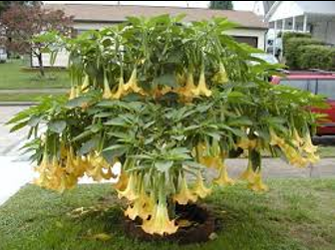See also
Poisonings - Acute Guidelines for Initial Management
Poisonings - Antihistamines / antihistamine-decongestant poisoning
Poisonings - Tricyclic antidepressant poisoning
Key points
- Many medications may have anticholinergic effects and interaction between two or more of these medications can lead to symptoms such as an agitated delirium, mydriasis, dry mouth and tachycardia.
- Serious symptoms include seizures, coma and cardiac conduction abnormalities and resolution of symptoms can be variable - delirium can persist for days following an acute ingestion
- Management involves symptomatic treatment and discussion with toxicologist when considering the need for decontamination or anticholinesterase use.
For 24 hour advice, contact the Victorian Poisons Information Centre on 13 11 26
Background
Anticholinergic syndrome results from competitive antagonism of acetylcholine at central and peripheral muscarinic receptors. Central inhibition leads to an agitated (hyperactive) delirium - typically including confusion, restlessness and picking at imaginary objects - which characterises this
toxidrome. Peripheral inhibition is variable - but the symptoms may include: hot, dry skin, flushed appearance, mydriasis, tachycardia, decreased bowel sounds and urinary retention. There is a spectrum of severity ranging from mild symptoms to a life-threatening condition - although seizures, coma and
cardiovascular toxicity may not be mediated by muscarinic effects, rather secondary to drug effects at other receptors, as many anticholinergic medications are active at numerous receptors / ion channels. Polypharmacy overdoses may make the anticholinergic toxidrome less apparent.
If anticholinergic syndrome is suspected please
seek senior advice and discuss with toxicologist.
Risk
assessment
Anticholinergic syndrome may occur following:
- The deliberate ingestion/self-poisoning of anticholinergic agents
- Accidental ingestion of anticholinergic agents
- Due to interactions between 2 or more anticholinergics, or increased susceptibility to standard doses of anticholinergics (more common in infants, children with Trisomy 21, spastic paralysis and blond/blue-eyed children).
Anticholinergic
agents
Atropine is the prototypical anticholinergic (anti-muscarinic) drug
| Class |
Agent |
| Anti-histamines |
Diphenhydramine, Doxylamine, Promethazine, Chlorpheniramine, Cyproheptadine |
| Anti-tussives |
Dextromethorphan |
| Antidepressants |
Tricyclic antidepressants (Amitriptyline, Imipramine, Doxepin) |
| Anti-psychotics |
Chlorpromazine, Droperidol, Haloperidol, Quetiapine, Olanzapine |
| Anti-convulsants |
Carbamazepine |
| Anti-emetics/travel sickness |
Hyoscine (scopolamine) |
| Topical ophthalmoplegics |
Cyclopentolate, Homatropine |
| Plants |
Deadly nightshade (Atropa belladonna), jimsonweed, mandrake root, lupin beans, Angel's Trumpet / Datura (see Figure 1) |
| Other |
Oxybutynin, benztropine, glycopyrrolate |


Figure 1: Examples of Angel’s Trumpet
Children
requiring Assessment
- Any symptomatic child
- All children or young person with intentional self-poisoning or significant accidental ingestion
History
and Physical Examination
Diagnosis is based on a history of ingestion/exposure to one or more anticholinergic agents and the presence of characteristic symptoms and physical signs.
The characteristic feature of toxicity at central receptors is agitated delirium. This may include:
- Restlessness / fidgeting /violent behaviour
- Visual hallucinations
- Picking at imaginary objects in the air or on the bedsheets
- Mumbling / slurred speech
- Fluctuating mental status
Other central signs include tremor, coma, increased tone, and seizures (rare).
The features of toxicity at peripheral and central receptors can be remembered using the following mnemonic
| "Hot as a hare": |
Fever |
| "Red as a beet:" |
Flushed skin |
| "Blind as a bat": |
Mydriasis |
| "Dry as a bone": |
Dry mouth, dry eyes and decreased sweating |
| "Mad as a hatter": |
Delirium |
| “Full as a flask” |
Urinary retention |
The severity of symptoms and signs is generally dose dependent.
| Mild
Anticholinergic Toxicity |
Moderate
Anticholinergic Toxicity |
Severe
Anticholinergic
Toxicity |
|
Tachycardia
Flushed face
Mydriasis and blurred vision
Dry mouth and skin
Fever |
Agitated delirium
Urinary retention
Hypertension
Hyperthermia |
CNS depression / coma
Seizures
Cardiac conduction abnormalities (QRS widening and increased QT interval)
Circulatory collapse / hypotension
Rhabdomyolysis |
The differential diagnosis to consider in cases of suspected anticholinergic syndrome includes:
- Other toxicological syndromes such as:
- Serotonin syndrome
- Neuroleptic malignant syndrome
- Malignant hyperthermia
- Salicylate toxicity
- Non-toxicological causes may include:
- Encephalitis
- Sepsis
- Neurotrauma
- Post-ictal phenomena
- Hypoglycaemia
- Hyponatraemia
- Behavioural disturbance
Investigations
- Screening tests - 12 lead ECG, blood glucose and paracetamol concentration - in deliberate self-poisoning.
- Some cough medications may also contain paracetamol - so a concentration should be considered in these accidental ingestions as well.
- Consider salicylate concentrations if differential includes salicylate toxicity.
- Consider concentrations for specific agents if available - eg carbamazepine
- Consider UEC and CK
Management
- Stop any causative agents
- Active resuscitation is infrequently required. Attention should be paid to the maintenance of airway, breathing and circulation.
- Hypotension should be addressed initially with a 20 ml/kg crystalloid bolus.
- Treat seizures with benzodiazepines
- Treat hypoglycaemia
- Treat hyperthermia with cooling measures. Antipyretics are unhelpful.
- Reassurance and management in a quiet area may be sufficient for those with mild signs/symptoms. These children often benefit from 1-to-1 nursing.
- Agitation / delirium is typically managed with titrated diazepam (0.1 mg/kg - to a max of 5-10 mg) PO every 30 minutes or every 15 minutes IV until the child is resting but able to be roused. Avoid haloperidol and droperidol, which may worsen anticholinergic effects.
- Urinary retention may contribute to the agitation. Bladder scan will reveal the need for a urinary catheter.
- The use of decontamination / enhanced elimination depend on the actual medication exposure, and should be discussed with a toxicologist.
- There exists some controversy over the use of physostigmine - a cholinesterase inhibitor - which has been used to reduce delirium in anticholinergic syndrome. The use of physostigmine may be indicated following discussion with the toxicology service.
When to
admit/consult local paediatric team
- Symptomatic children require admission for monitoring and treatment if necessary
- Resolution of symptoms is variable, and delirium can persist for days following an acute ingestion.
For 24 hour advice, contact the Victorian Poisons Information Centre on 13 11 26
When to
consider transfer
Children requiring care beyond the comfort level of the current hospital
For emergency advice and paediatric or neonatal ICU transfers, call the Paediatric Infant Perinatal Emergency Retrieval (PIPER) Service: 1300 137 650.
Discharge
requirements
- Asymptomatic children at risk of anticholinergic syndrome - with deliberate self-poisoning or significant accidental ingestion should be observed for 6 hours.
- Prior to discharge, all children require:
- Normal GCS
- Normal ECG
- Ensure provision for safe discharge are in place
- In cases of deliberate ingestion, a risk assessment should indicate that the child or young person is at low risk of further self harm in the discharge setting.
Discharge
information and follow-up:
Accidental ingestion: Parent information sheet from Victorian Poisons Information centre on the prevention of poisoning
Intentional self-harm: Referral to local mental health services e.g. Orygen Youth Health: 1800 888
320
Recreational poisoning: Referral to YoDAA, Victoria's Youth Drug and Alcohol Advice service: 1800 458 685
Information Specific to RCH/ MMC
All patients with intentional ingestions, should be admitted under the adolescent or psychiatric units
Last updated August 2017